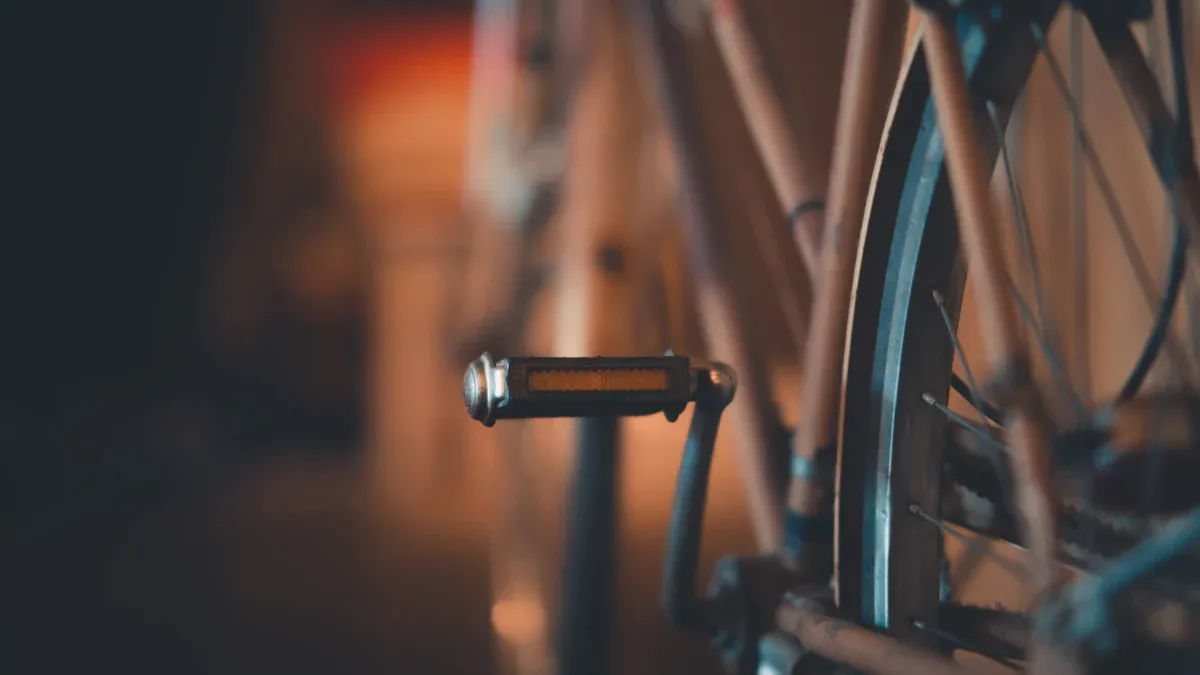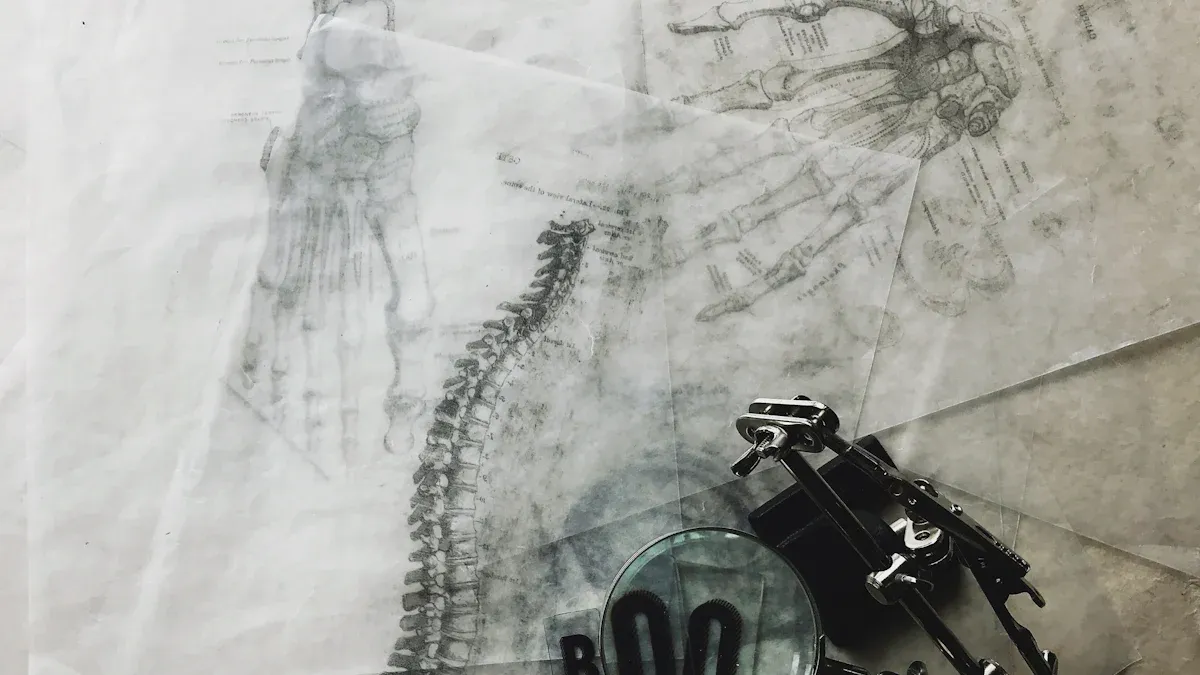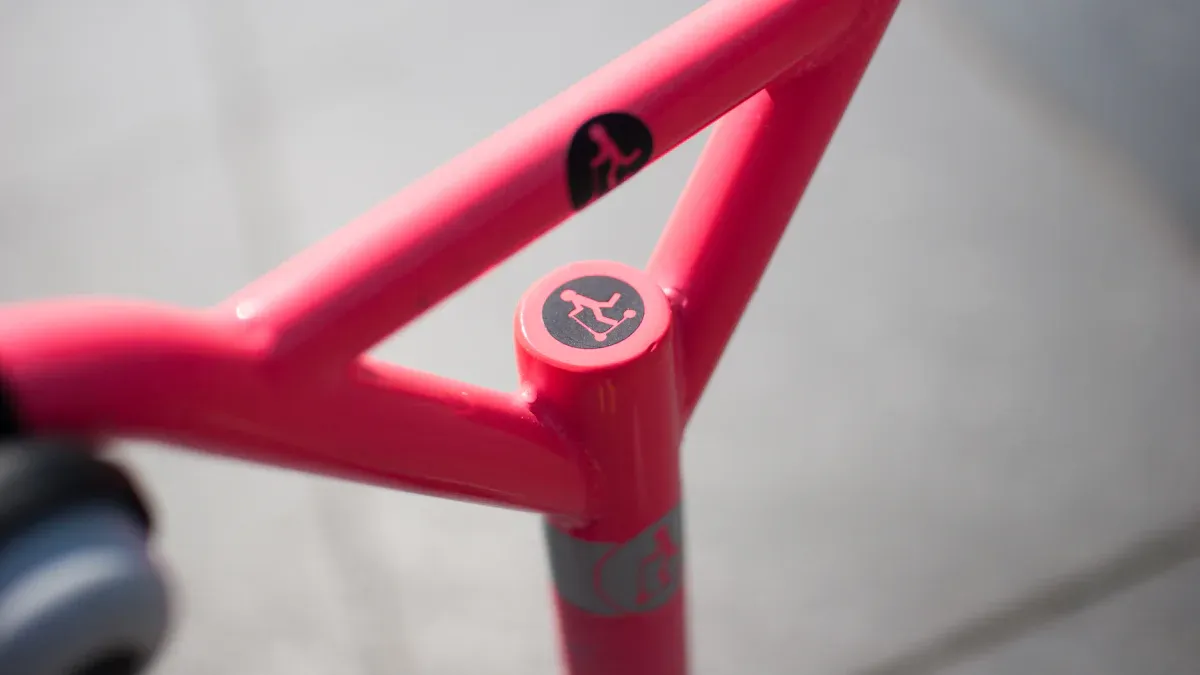
Bike frame name of parts are very important for your bike. Each part helps determine how well your bike works and stays steady. Knowing the names of these bike frame parts helps you take care of your bike. You can also change your bike’s wheel parts when you know what each one does. Understanding the bike frame name of parts helps you make smart choices about upgrades and repairs.
Key Takeaways
Knowing bike frame parts helps you take care of your bike. It also helps you make upgrades easily.
The top tube affects how stable your bike is. It also changes how easily you can get on and off.
Chainstay length affects bike stability and how it responds while riding.
Understanding dropouts is important for putting wheels on correctly. It also helps with adjustments.
Knowing bike parts makes your cycling experience better and safer.
Frame Parts

Top Tube
The top tube connects the seat tube to the head tube. It goes straight across the bike frame. This part is very important for the bike’s structure. A strong top tube keeps the bike stable while riding. It also changes how you get on and off the bike. A higher top tube makes it harder to mount, while a lower one is easier to use.
Down Tube
The down tube links the head tube to the bottom bracket. It usually angles downwards. This part is key for moving power from your legs to the bike. A strong down tube helps your pedaling energy push the bike forward. Many modern bikes use materials like aluminum or carbon fiber for the down tube. These materials are strong and light, improving your ride. Here’s a quick look at some common materials used for down tubes:
Material | Properties | Reasons for Use |
|---|---|---|
Carbon Steel | Strong, long-lasting, but heavier than chromoly. | Commonly used due to its durability and cost-effectiveness. |
Chromoly Steel | Light, strong, responsive, and offers good flex. | Preferred for its balance of weight and strength, making it ideal for performance bikes. |
Aluminum | Light, strong, stiff, and corrosion-resistant. | Widely used for its affordability, low maintenance, and versatility in design. |
Titanium | Lighter than steel, strong, and flexible. | Used in high-end bikes for its durability and shock-absorbing properties. |
Carbon Fiber | Very light and tough when designed correctly, but can be brittle. | Offers high performance and weight savings, though requires careful engineering to avoid brittleness. |
Seat Tube
The seat tube connects the bottom bracket to the seat. It holds the seat post, which lets you change your riding position. The angle of the seat tube can really affect your comfort and performance. A steeper angle helps you ride more aggressively, which can make you faster. Research shows that cyclists do better in a forward position, which helps with muscle use and comfort.
Knowing the parts of a bike frame, like the top tube, down tube, and seat tube, helps you see how each part affects your bike’s performance. Understanding these parts helps you make smart choices about upgrades and maintenance.
Bike Frame Name of Parts
Chainstays
The chainstays are two tubes that connect the bottom bracket to the rear dropout. They are very important for the bike’s rear triangle, which has the seatstays. Chainstays help move power from your pedals to the rear wheel. A longer chainstay, usually about 450-470mm for touring bikes, gives better stability and comfort when climbing. Shorter chainstays, around 430-435mm, can make the bike more responsive during sprints.
Tip: When picking a bike, think about the chainstay length for your riding style. Longer chainstays give stability, while shorter ones can help with agility.
Seatstays
The seatstays connect the top of the seat tube to the rear dropout. They are key for the bike’s strength and ride quality. Seatstays help soak up bumps from the road, making your ride smoother. Research shows that lateral compliance in seatstays is important for comfort. This means they can bend a little to reduce vibrations, improving your overall experience.
Evidence | Description |
|---|---|
Lateral Compliance | Studies show that lateral compliance is important for comfort while riding, as it helps reduce vibrations from the trail. |
Vertical Compliance | The frame’s design, especially the seatstay connection, limits vertical compliance, which matters less for comfort. |
Vibration Damping | Measurements indicate that some frame designs reduce vibrations better at certain frequencies, affecting ride quality. |
Head Tube
The head tube connects the front fork to the bike frame. It is very important for steering and handling. The angle of the head tube affects how easily you can turn the front wheel. A steeper head tube angle helps balance at low speeds but may cause oversteering. On the other hand, a slacker angle gives more stability at high speeds, making it harder to steer but safer overall.
Note: The head tube angle is a key factor in how much effort it takes to turn the front wheel. Knowing this can help you choose a bike that fits your riding style.
Parts of a Road Bike Frame

Fork
The fork is an important part of a road bike frame. It connects the front wheel to the bike and helps you steer. Road bike forks are made for precise steering and good shock absorption. This design helps keep balance and improves speed and agility. You often see road bike forks made from light materials like carbon fiber or aluminum. These materials make the bike lighter while also making it stiffer and more comfortable.
Tip: Carbon fiber forks are great at reducing vibrations. This makes them perfect for long rides on smooth roads, so you can ride longer without feeling uncomfortable.
The shape of the fork is also very important for how your bike handles. The fork’s offset and head angle affect the trail figure, which is key for bike stability and quick responses. A slacker head angle increases trail, which slows down steering. This can make handling harder, especially in tight turns.
Bottom Bracket
The bottom bracket is another key part of a road bike frame. It connects the crankset to the bike and helps you pedal well. The design of the bottom bracket is different for road bikes and mountain bikes. Here’s a quick comparison:
Feature | Road Bikes | Mountain Bikes |
|---|---|---|
Shell Width | 68mm (ISO), 70mm (Italian) | 68mm or 73mm |
Spindle Length | Shorter | Longer |
Use of Spacers | No | Yes |
Cup Thickness | Thicker (approx. 11.2mm) | Thinner (approx. 10.2mm) |
Compatibility with E-type FD | Not applicable | Accommodates |
Modern bottom brackets with cartridge bearings are usually not meant to be serviced. It can be hard to reach the bearings, and makers might not give service instructions. To help your bottom bracket last longer, don’t spray water directly at the bearings. Riding in wet weather can hurt bearing life. Regularly cleaning and greasing the spindle interface is a common maintenance task for external cranks.
Knowing the parts of a road bike frame, like the fork and bottom bracket, helps you see how these parts improve your bike’s performance. Each part has a special role in making your ride smooth and efficient.
Bike Part Names and Functions
Rear Triangle
The rear triangle of a bike frame includes the chainstays, seatstays, and rear dropouts. This part is very important for handling, stability, and power transfer. The chainstay helps move power from your pedals to the back wheel. It gives a strong base that stops bending and twisting when you pedal. A good rear triangle helps spread weight evenly, which makes your bike work better.
Longer chainstays give stability, which is good for climbing.
Shorter chainstays help with quick turns, making them easier to maneuver.
Knowing about a bike’s parts, especially the rear triangle, helps you make smart choices about upgrades and repairs. For example, if your bike feels unstable while riding, you might want to try a bike with a different rear triangle design.
Dropouts
Dropouts are the slots where the back wheel connects to the bike frame. They come in different types, like vertical and horizontal dropouts. Vertical dropouts make it easy to put on the wheel without adjustments. This feature helps prevent misalignment. Horizontal dropouts let you make small changes to the axle position. This is helpful for fitting different frame sizes and chainstay lengths.
Vertical Dropouts: Easy to remove the wheel but can loosen on bumpy paths.
Horizontal Dropouts: Let you adjust chain tension, often used in single-speed bikes.
Thru-Axles: Offer a strong mounting system, stopping wheels from loosening.
Knowing bike part names, like dropouts, is important for maintenance. Understanding these terms helps you fix your bike better. Not knowing the right words can lead to mistakes in repairs, which can cause problems later.
Understanding how the rear triangle and dropouts work not only makes your ride better but also helps you take care of your bike well.
Knowing about bike frame parts is important for taking care of your bike and making changes. When you learn the names and jobs of each part, you can make smart choices about your bike. This helps you feel more comfortable and ride better.
Here are some good reasons to know bike frame parts:
You can pick parts that match your riding style.
You will see how different materials change your bike’s performance.
You can have safer and smoother rides.
By getting to know these terms, you make your cycling experience better and help your gear last longer.
FAQ
What is the purpose of the top tube on a bike?
The top tube connects the seat tube to the head tube. It helps support the bike’s structure and affects how you get on. A strong top tube makes the bike more stable while riding.
How do chainstays impact bike performance?
Chainstays connect the bottom bracket to the rear dropout. They help transfer power from your pedals to the back wheel. Longer chainstays give more stability, while shorter ones make the bike quicker to turn.
Why is the bottom bracket important?
The bottom bracket connects the crankset to the bike frame. It helps you pedal smoothly. A good bottom bracket makes pedaling easier and improves how well the bike works.
What are dropouts used for?
Dropouts are the slots where the back wheel connects to the bike frame. They can be vertical or horizontal. Vertical dropouts make it easy to put on the wheel, while horizontal dropouts let you adjust chain tension.
How does the head tube angle affect handling?
The head tube angle affects how you steer and handle the bike. A steeper angle helps with balance at low speeds but can cause oversteering. A slacker angle gives more stability at high speeds, making it safer to ride.
See Also
Understanding Bike Frame Components And Their Key Functions
Essential Components Of Bike Frames And Their Functions
Key Bike Frame Parts Every Cyclist Must Be Aware Of
Differences Between Fat Bike Frames And Mountain Bike Frames
